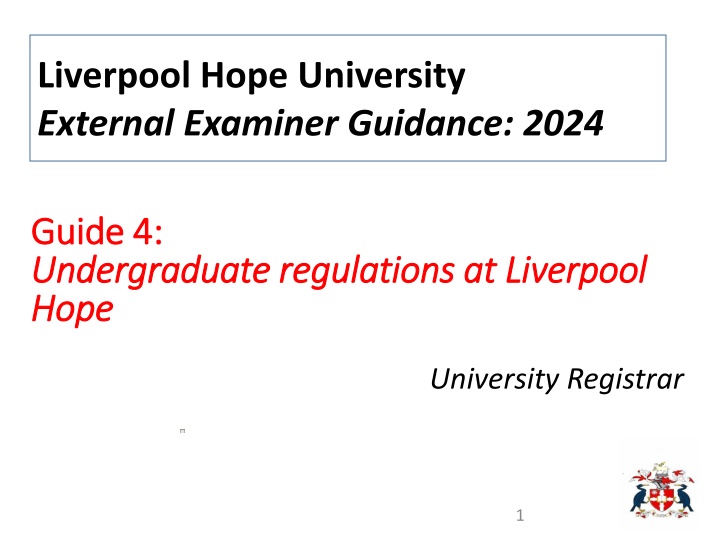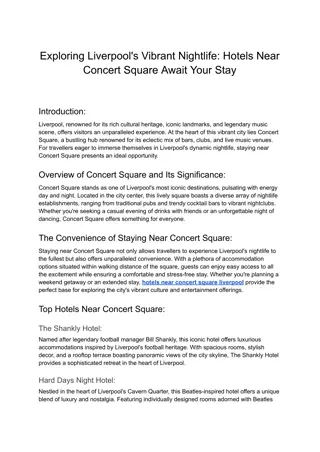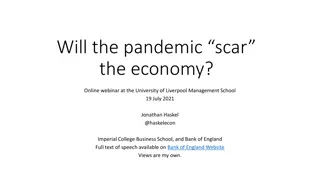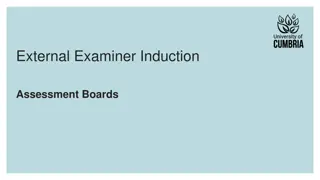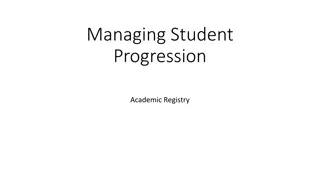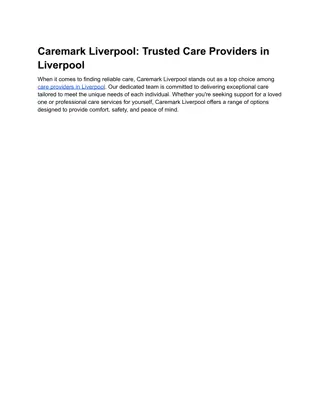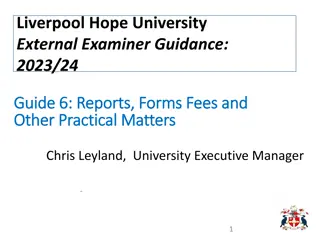Liverpool Hope University External Examiner Guidance 2024: Curriculum Structure and Progression Rules
Explore the curriculum structure at Liverpool Hope University for undergraduate programs, including standard and non-standard variations, assessment regulations, and progression rules. External examiners play a crucial role in confirming individual marks, grades, and aggregate scores. Navigate through different academic blocks and learn about the implications for externals in assessing student performance.
Download Presentation

Please find below an Image/Link to download the presentation.
The content on the website is provided AS IS for your information and personal use only. It may not be sold, licensed, or shared on other websites without obtaining consent from the author.If you encounter any issues during the download, it is possible that the publisher has removed the file from their server.
You are allowed to download the files provided on this website for personal or commercial use, subject to the condition that they are used lawfully. All files are the property of their respective owners.
The content on the website is provided AS IS for your information and personal use only. It may not be sold, licensed, or shared on other websites without obtaining consent from the author.
E N D
Presentation Transcript
Liverpool Hope University External Examiner Guidance: 2024 Guide 4: Guide 4: Undergraduate regulations at Liverpool Undergraduate regulations at Liverpool Hope Hope University Registrar 1
1. Curriculum Structure (a) Standard curriculum structure [some variations exist see next slide]: o Level 4 [ Certificate or C ] 2 60-credit blocks [typically Foundations in .], Single Honours: Core Block 1 and Core Block 2 Combined Honours: One Core Block from each Subject. o Level 5 [ Intermediate or I ] 2 60-credit blocks [typically Explorations in .,], as for 4[C], o Level 6 [ Honours or H ] 2 45-credit blocks [typically Advanced Studies in .], as for 4[C], 1 30-credit research block Single honours: Dissertation Combined Honours: either 2 Research Projects or Integrated Dissertation combining both subjects. 2
1. Curriculum Structure (b) Some non-standard structures. o Psychology ALWAYS has a Research Block comprising a 30-credit Dissertation, even for Combined Honours students. o BA Creative & Performing Arts, BA Social Work and BA Primary Education have 120-credit blocks [C/I] and either a 120 block at Level H or a 90-credit block plus a 30 credit research block at H. 3
1. Curriculum Structure (c) All assessments are attached to the block o Academics can set assessments that transcend parts of the block. If a block in BA History covered Medieval and Modern History, the block might be assessed in part by an exam requiring students to pull together themes from the medieval and modern periods. o All credits are attached to the block, so passing a block is all-or-nothing. If students fail a block following resits, and need to retake with attendance, they retake the whole block. 4
1. Curriculum Structure (d) Implications for Externals o You will be asked to confirm: marks & grades for individual assessments, and aggregate marks & grades for blocks. o You might be asked to look at an integrated dissertation [eg in Education & Music]. 5
2. Progression and Completion Rules (a) Scope of the Rules o Continuation from C to I o Continuation from I to H o Completion of Level H (or Continuation to Level M for Integrated Masters students) 6
2. Continuation and Completion Rules (b) RULE ONE: All Level F and C students, All single honours students at Levels I/H and M: Must get an aggregate mark of 40 or higher for their current Level. All Combined Honours students at Levels I and H: Must get an aggregate mark of 40 or higher for both of their subjects Students who get 35-39 in one of their subjects may be able to change to single honours if they have passed their second subject 7
2. Continuation and Completion Rules (c) For all students RULE TWO: Pass any assessments designated as Qualifying Components , or groups of assessments designated as QualifyingSets OR meet any other requirements of professional bodies. RULE THREE: Have attempted all assessments, if you have any non submission outcomes you will not be able to progress or complete. This includes not just non submissions but also assessments not yet submitted due to mitigating circumstances. This also applies where a mark of 0 is associated with academic misconduct. 8
2. Continuation and Completion Rules (e) Implications for Externals: o You need to be satisfied with the standards used to assess each assessment. If Level I History Core is assessed by a Nazi Germany essay, a Slave Trade essay, a Roman Britain presentation and a History of Britain exam, you need to see samples for all 4 components. o Scrutinise work at the Pass/Fail boundary for qualifying components . If students can only progress if they pass the Nazi Germany essay, you need to pay particular attention to this assessment. o Ask for the sample to include all work for a block by selected students. This will enable you to judge whether, overall, the students have met block-wide learning outcomes. 9
3. Degree Classification Rules STAGE A: Applying 2 Methods to Calculate the Overall Aggregate Mark o Procedure We will calculate the overall aggregate mark in TWO ways: METHOD 1 (Level C mark x 10% ) + (Level I mark x 30%) + (Level H mark x 60%). METHOD 2 (Level I mark x 25%) + (Level H mark x 75%). o Example A student s marks are: Level C 55; Level I 62; Level H 75. METHOD 1 (55x10%) + (62x30%) + (75x60%) = 5.5 + 18.6 + 45 = 69.1. METHOD 2 (62x25%) + (75x75%) = 15.5 + 56.3 = 71.8. 10
3. Degree Classification Rules for Bachelors awards STAGE B: Deciding which Method gives the Higher Overall Aggregate Mark o Procedure We will select the higher of the two aggregates obtained in stage A. o Examples STUDENT 1 Overall aggregate mark [Method 1] = 69.1. Overall aggregate mark [Method 2] = 71.8. We will select 71.8 [the result from Method 2]. STUDENT 2 Overall aggregate mark [Method 1] = 66.6. Overall aggregate mark [Method 2] = 64.8. We will select 66.6 [the result from Method 1]. 11
Integrated Masters Degrees Are calculated using the same methodology but using the following two algorithms: 1. the Overall Aggregate, combining marks from Level C [weighted 5%], Level I [weighted 25%], Level H [weighted 30%] & Level M [weighted 40%]; 2. the Overall Aggregate, combining marks from Level I [weighted 25%], Level H [weighted 25%] & Level M [weighted 50%]; 12
Borderline cases Borderline cases Where the overall aggregate falls within two rounded marks of the classification borderline the students profile will be scrutinised further at the examination board. Such borderline candidates will have their Level H/M profile considered in more detail before confirming their overall degree classification. The higher classification will be awarded if the Level H/M profile confirms that the student achieved, on initial assessment, a minimum of 60 credits approved for that award at the higher classification. 13
Degree Classification Rules implications for externals Level F [3] is not included in the FINAL degree classification rules. You should see a sample of Foundation year work, but this may be a smaller sample than at other levels of study. Level C[4] might count, so you will need to see a sample of work. o This can be smaller than the samples for other Levels. 14
4. Redeeming Fails (a) Failure of Individual Assessments o Failure of a Qualifying Component cannot be condoned, irrespective of the overall aggregate. The student may, however, progress on a non-accredited award should they opt to do so. o Students who have provisionally not passed an assessment are normally allowed to re-submit their work before the Subject meeting, to try to increase their mark to a bare pass. This is in addition to reassessment opportunities offered by the Board, and marks presented to the Board will reflect any adjustments following re-submissions .] 15
4. Redeeming Fails (b) Failure of Blocks [i] o Students normally have up to three redemption opportunities: reassessment of failed components at the next assessment period then a single opportunity to retake the entire block, with attendance then reassessment of failed components. o The right to reassessment is normally forfeited if .. EITHER the aggregate mark for the block is 24 or lower OR the failed assessment[s] were based on practical work which the student had not undertaken [unless it would be practicable for the work to be undertaken in the reassessment period]. 16
4. Redeeming Fails (c) Failure of Blocks [ii] o The right to retake with attendance is normally forfeited if .. This was the outcome of an academic misconduct investigation, OR it would not be possible for the student to retake without violating the maximum duration for the Programme. o If a student fails professional practice .. the Examiners are entitled to forfeit a reassessment [or retake] opportunity irrespective of the aggregate academic mark. 17
4. Redeeming Fails (d) Capping Rules o Following reassessment: marks for individual assessments are capped at a bare pass There is no capping at block level following reassessment. o Following a retake with attendance [or alternative]: marks for individual assessments uncapped; aggregate marks normally uncapped unless the fail relates to academic misconduct. 18
4. Redeeming Fails (e) Implications for Externals o Make sure you are confident about overall Block Aggregates around the 24/25 boundary. This probably means you need to get an overview of some students work. 19
5. Mitigating Circumstances: fit to sit policy Outline o If students submit work, they are deemed to be declaring that they are fit to be assessed . o Requests by students for the policy to be waived are handled by the mitigating circumstances policy. Implications for Externals o Work sent to you should have been marked strictly on its merits. o Aggregate marks presented to Boards should have been calculated strictly in accordance with approved weightings. o Award classifications will be agreed solely on the basis of the profile of marks. o You will not be expected to form judgements about how much better students might have performed if circumstances had been different. 20
5. Mitigating Circumstances: students who think they are not fit to be assessed Outline o They should apply for a concession: extension [mark available at the Board]; deferral of assessment [no mark until the next Board M grade shown]; interruption of study; special assessment arrangements / alternative assessments. o Once a concession has been granted, the work is assessed as normal. o Detailed policies on the University s website cover valid grounds, type of evidence required, procedures, and responsibility for granting requests. o Cases should have been dealt with before the Board. Implications for Externals o You are not directly involved, but make sure that the Board seeks an assurance that any M grade has been arrived at via due process. 21
6. Academic Misconduct Outline o Detailed policies on the University s website cover penalties and procedures. o Academic Misconduct Policy o Cases should have been dealt with before the Board. o Cases identified on Board transcripts by PL grades. o Boards accept recommendations as long as due process has been followed. Implications for Externals o Make sure that the Board seeks an assurance that any PL grade has been arrived at via due process. o If you suspect misconduct, notify the Assessment Co-ordinator asap, and ask for the matter to be investigated by due process. 22
8. And finally We hope you have found this presentation useful. If you have any queries please email Dr Cathy Walsh [University Registrar] at walshc@hope.ac.uk 23
